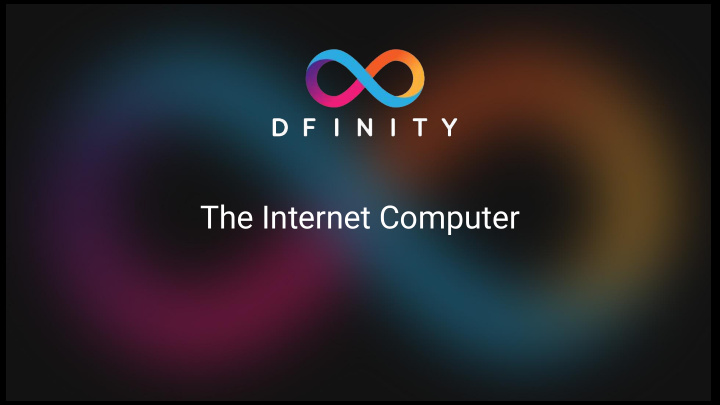



The Internet Computer
Tonight we’ll explore . . . The need for a new global business and information infrastructure The emergence of a new computing paradigm: WebAssembly & Cloud 3.0 Combining WebAssembly & Blockchain The importance of randomness How DFINITY generates randomness
The global information infrastructure is frail
The Problem: Hosting Logic & Data is A Pyrrhic Game SOME HEADER TEXT Vulnerable to Vulnerable Vulnerable to Business infrastructure to data-theft data-harvesting Dependency failure Self-Hosted X X (owned infrastructure) Cloud-Hosted X X X (AWS, Azure) Outsourced X X X X (Global Payments, Gmail)
Black Elephants SOME HEADER TEXT 2011: Human error during a system upgrade knocks out much of AWS service for 5 days 2012: Global Payments loses 1.5 Million credit card numbers 2013: Cambridge Analytica rears its ugly head 2016: Europe adopts the General Data Protection Regulation 2016: Storms in Sydney knock out AWS service for 10 hours 2017: Yahoo announces that in two hacks in 2013 and 2014 it lost 3 Billion usernames and passwords (everything) 2018: Maersk recovers from NotPetya ransomware incident by reinstalling over 4,000 servers, 45,000 PCs, over the course of ten days in late June and early July 2017.
SWIFT’s global business interoperation infrastructure is fragile 2015–2016 $101 million stolen 02/2018 $2 million 10/2017 $61 million stolen in several attacks on Stolen from City Union from Taiwanese bank Bangladeshi central bank and Bank, Bangladesh Vietnamese & Ecuadorian commercial banks. 04/2017 We learn the NSA Sometime in 2017 $6 million stolen in Russia hacked SWIFT for surveillance bank attack purposes
Worse by the year SOME HEADER TEXT A study conducted by Juniper Research has indicated that rapid digitisation of consumers’ lives and enterprise records will increase cost of data breaches to approximately $2.5 trillion globally—almost four times the estimated cost of breaches in 2015.
We need a new Infrastructure SOME HEADER TEXT Does not fail due to ransomware Is not controlled by gatekeepers Won’t fail at any moment due to human error Does not expose the user to data theft or surveillance Cannot be manipulated by an attacker Is structurally robust Automated, Replicated, Decentralized
WebAssembly, Cloud 3 & Blockchain
SOME HEADER The next generation software development standard. TEXT Allows one to program in the most appropriate language for an application Can run on any computer or phone, currently in browser Is sandboxed and deterministic
Cloud 3: Local + remote storage and execution in a single runtime environment Interface downloaded to phone as application is opened. Heavy storage and compute happens on cloud Appropriate storage and compute happens on device. Never update an app again
WASM + Blockchain: The Internet Computer High security services requiring 100% uptime use a Blockchain for remote storage and execution. High performance Internet Computer will be cheaper than centralized cloud due to lack of labour costs
The value of randomness SOME HEADER TEXT If we can agree that a source of randomness is Unmanipulable & Unpredictable We don’t need an expensive consensus algorithm to secure a distributed computing network. This makes it cheap to run programs in this environment and easy to scale.
Generating Randomness
Threshold signatures 1 SOME HEADER TEXT Public Key Private Key Asymmetric Key Cryptography Threshold Cryptography
Threshold signatures 2 SOME HEADER TEXT Private Key Deterministic Signs DATA verifiable signature produced Asymmetric Key Cryptography Threshold Cryptography
DFINITY Consensus: Threshold Signatures and SOME HEADER Notarization Committees TEXT Each round, or block, a randomly selected Notarization Committee is selected to create randomness and notarize blocks for inclusion in the blockchain Round 1 Round 2 Round 3
DFINITY Consensus: Threshold Relay 1 SOME HEADER TEXT Use Randomness to Committee runs Committee members select Notarization Distributed Key sign the randomness Committee Generation that selected them Algorithm The new complete Signature shares are signature is used as gossiped onward and randomness to select aggregated the next Committee
DFINITY Consensus: Threshold Relay 2
DFINITY Consensus: Block Signing
DFINITY: SOME HEADER TEXT Cannot fail due to ransomware Is not controlled by gatekeepers Won’t fail at any moment due to human error Does not expose user to data theft or surveillance Cannot be manipulated by an attacker Is structurally robust
SOME HEADER TEXT arthur@dfinity.org DFINITY.org DFINITY.org/jobs @ecfGe81VMJ3iko5++/KfD51om fNtLSd50nS1omUyj/Y=.ed25519
Social Consensus
Built-in governance SOME HEADER TEXT There must be a way for the users to determine the behavior of the network Client updates must be frequent and contention free Updates must be reversible Undesirable programs must be able to be stopped from running Malfunctioning programs must be able to be fixed Network forks are not an acceptable outcome of protocol or state changes
The Blockchain Nervous System: Proposals and proposers Proposals may: Upgrade the protocol ○ Freeze undesirable programs ○ Fix broken programs (unfreeze funds) ○ Proposers might be: Protocol developers ○ Concerned citizens ○ Businesses using the platform ○ Machine actors identifying optimisations ○ potentially managing sharding
The Blockchain Nervous System: Voting and execution Participants must place a security deposit with a long unbonding period A fee or bond must be paid along with the proposal Opaque Liquid Democracy structure If the proposal passes it is sent to the BNS “SuperUser” module The SuperUser module, with unique permissions, executes the proposal Bonded voting nodes (Neurons)
Recommend
More recommend